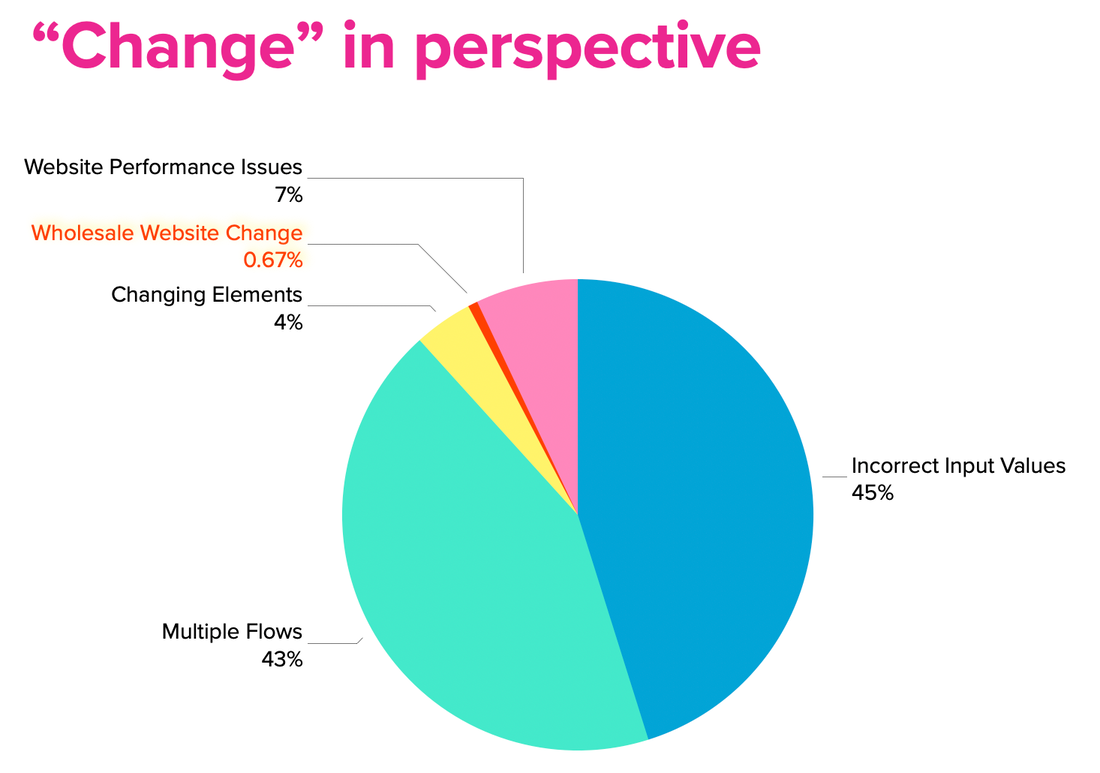|
A common misconception is automation on the web is unstable, high maintenance, and hard to scale because websites simply change too often — resulting in a constant cat-and-mouse game.
However, after looking at over 1M automations, over multiple months, on Weeldi the numbers tell a different story. 45% of automations fail because the customer input data is wrong. These are issues like invalid log-in credentials, invalid account numbers, incorrect scheduling, incorrect payment information, and attempting to capture data that doesn't exist. Weeldi’s API and User Interface allows users to update this input data on demand and classifies errors by customizable error type with supporting screenshots, so users can quickly (and automatically) identify and fix automations failing due to incorrect input data. Ultimately, if you want automation to succeed you need your input data to be clean and up-to-date. 43% of automations fail because of multiple website versions. This is most commonly believed by users to be a change with a website, however it is instead a new version of the same website, which they have yet to come across while automating. As you scale the Job volume behind each automation you see different scenarios you didn’t see before. This is commonly a result of regional differences, AB testing, or different account types on the same website. Weeldi’s automation engine supports multiple flows per website allowing customers to record multiple automations per website. Then Weeldi uses AI to figure out which automation works per Job and memorizes this for future runs, increasing automation success and removing painful guesswork for users. Simply put, volume strengthens automation. 7% of initial automations fail because of website performance issues. This means the website is down, loading too slowly, not returning a query. Generally, these are temporary issues and occur during website updates or more often on websites pulling data from several legacy systems, as at any given moment one of those systems may be down. (e.g. vendor websites like utilities, telcos, suppliers, etc.) Weeldi enables reattempt scheduling by automation, which means if a website is down, slow, or not returning an expected result, Weeldi will reattempt within a configurable timeframe until the website can complete the automation successfully. 4% of automations (if using RPA) will fail because of changing elements. Websites are built using HTML tags. A common example, a pay bill button may be implemented as element type BUTTON, but upon a new website update, it may have been changed to DIV, SPAN, or INPUT. These are tricky because while nothing may change to the human eye, these tag changes will stop traditional automation tools like RPA dead in their tracks. Since Weeldi automatically solves for these changes (as described below) instead of tracking failures, we tracked how often our automation engine had to solve for these changes. Weeldi’s proprietary approach to automating on the web takes into account a more complete description of the webpage (not just HTML tags) and uses AI to add an abstraction layer above the webpage, allowing the Weeldi automation engine to view web pages like a human. This means if an HTML tag changes, an element moves, or an element is named differently, chances are very high Weeldi will navigate through it ensuring the automation completes successfully. .67% of automations fail because of wholesale website UI changes. Wholesale website UI changes are often assumed to be the primary reason for web automations breaking, however wholesale website UI changes are by far the least common reason why Weeldi automations break. The reality is wholesale UI changes take a lot of time and endanger the user experience, which means they don't happen frequently. Weeldi’s automation engine is equipped with tools that make it clear when automations are failing and why they are failing, including supporting screenshots and error details. This makes it immediately obvious when a complete website UI change has taken place. The next step is adjusting to the new change and this is where Weeldi's No Code Recording Engine (a Chrome Extension that runs in your Google Chrome Browser) allows non-technical users to quickly record a new or updated web automation in just minutes. About Weeldi Headquartered in the San Francisco Bay Area Weeldi enables companies of any size or technical ability to stably automate processes on the web, at scale, through its web service API or user interface — with no coding required. Comments are closed.
|
WeeldiTransform a website into an API in seconds w/ no coding required. Archives
June 2024
Categories |




